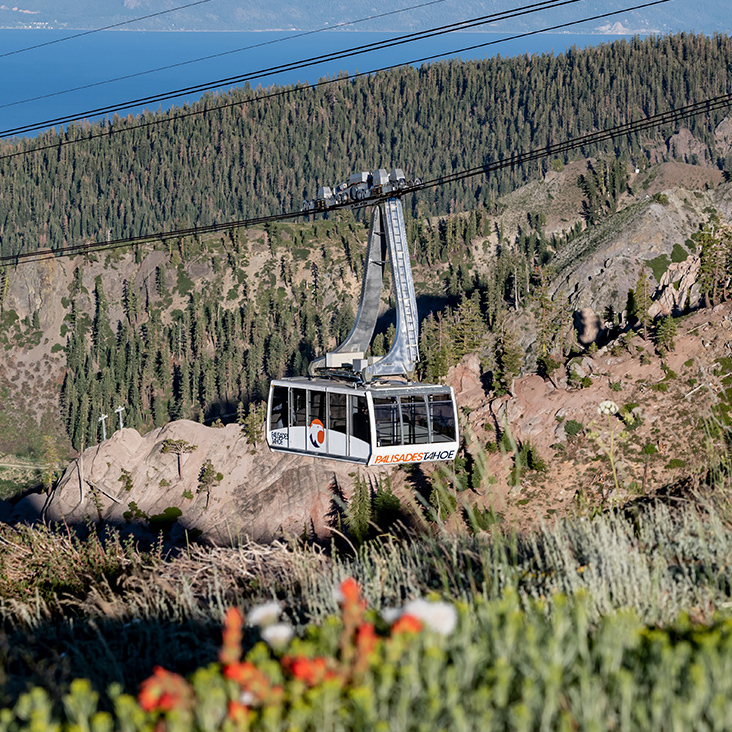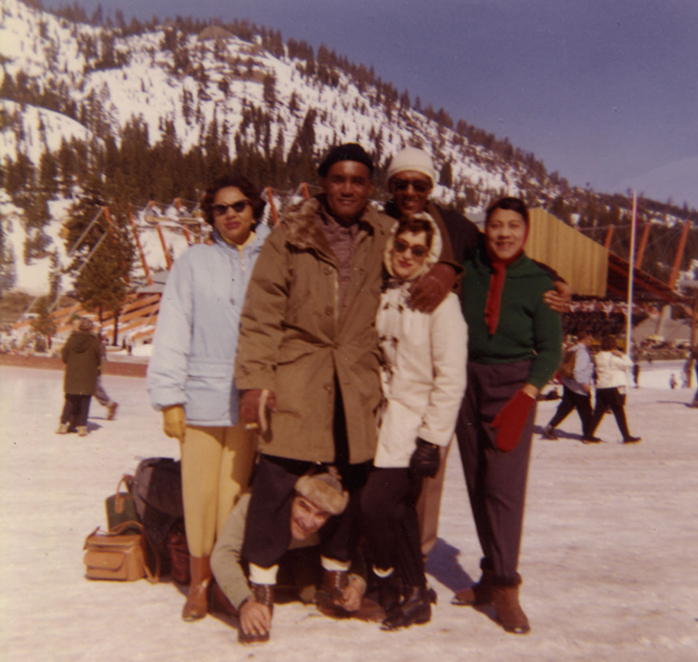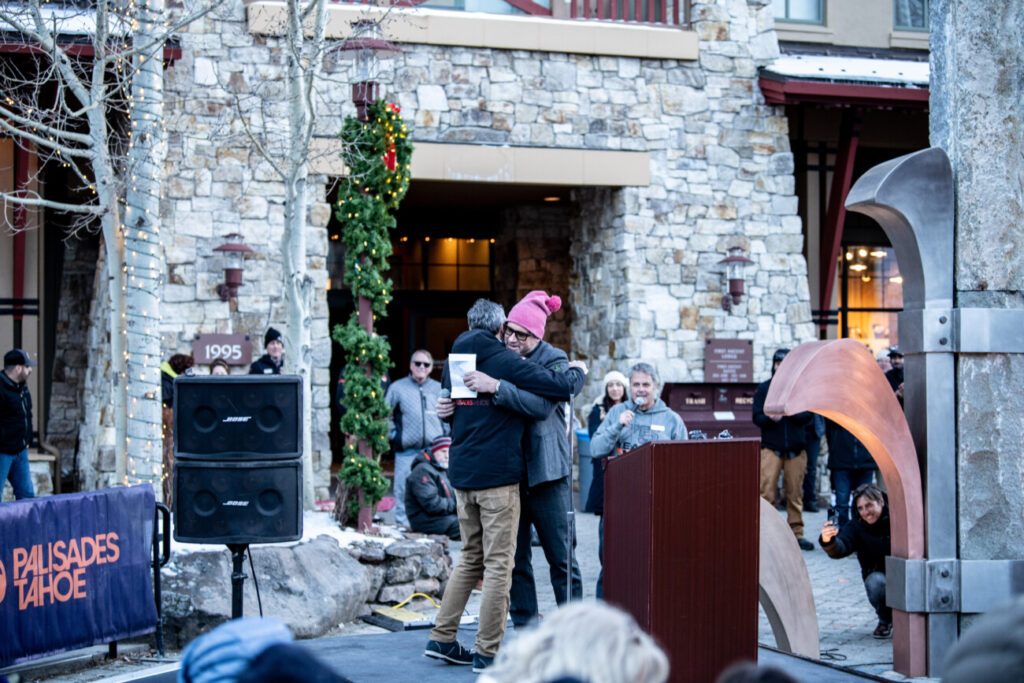This piece was written by Nancy O’Connell, Associate Editor of the Palisades Press. Part of the Sierra Ski Heritage Oral History Project, Shared History University of Nevada, Reno.
If you’re well-versed in local Olympic lore, you’re familiar with former resort President Alec Cushing’s decision to throw his hat into the ring after reading a small news item about Reno’s bid for the 1960 Winter Olympics.
While the bid was initially a publicity stunt to generate interest in the resort, Cushing correctly surmised that the United States Olympic Committee was not likely to select Reno as a site, given the state’s reputation as a divorce haven, and its laws allowing legalized gambling and prostitution.
Photo above: The Hall-Pittman family at the 1960 Winter Olympics. Tarea Hall Pittman (far right) was the Western US Regional Director for the NAACP and played a key role in Nevada’s fight for civil rights. Courtesy Tarea Hall and William Pittman Papers, MS 46, African American Museum and Library, Oakland, CA

He was correct and on January 7, 1955, Sq**w Valley was selected as the United States Olympic site. Several months later, in Paris, the fledgling resort won the bid over the odd-on favorite, Innsbruk, by the slimmest margin of two votes. Those Games were widely known for the number of firsts, including the first purpose-built Olympic Village, the first use of electronic timing, the first time computers were used to calculate results, and the first live broadcast of the Games.
The most important thing in the Olympic Games is not to win, but to take part, just as the most important thing in life is not the triumph but the struggle. The essential thing is not to have conquered, but to have fought well.
– Baron Pierre de Coubertain, Founder of the modern Olympic movement
The 1960 Winter Olympics marked another important first: because of the Games, it was the first time Reno was integrated as a city. While the Olympic events took place here in Olympic Valley, Reno, just forty miles across the border, stood ready as the gateway city, serving as the base of operations, with an airport, abundant lodging facilities, and other amenities to cater to the thousands of spectators eager to attend the Winter Olympics. Despite its proximity to California, where race relations were far more progressive, most cities and towns in Nevada were heavily segregated.

The 1960 Winter Olympic Games were transformative for Reno. Segregation and lack of opportunity marked the lives of Black Renoites. During the struggle for civil rights, the city gained the moniker “the Mississippi of the West.” According to interviews with activists, most business establishments displayed “Whites Only” signs at their entrances, as far back as the mid-1930s.
Reno’s openly racist culture was a direct affront to Olympic ideals and everything the Games stood for and symbolized. As the games approached, the eyes of the world turned to Sq**w Valley and Reno in the first live broadcast of the Olympic Games. But the city’s discriminatory practices threatened to serve as fodder for the Soviet Cold War propaganda machine, as further proof of American depravity.
A few months after being sworn into office in 1959, Nevada Governor Grant Sawyer received a call from the United States Department of State. In his oral history recorded in 1991, Sawyer recounted that story. “There was an ambassador from a black African nation, driving through the West and he was attempting to check in to a Las Vegas hotel and was being refused.” Sawyer had to personally call the hotel and speak with the owner, ultimately convincing him to rent a room to the ambassador.
“The incident was representative of the overall situation in Nevada,” Sawyer said. He was deeply concerned. “People would be coming to our state from all over the world . . . and we had to advocate a special departure from common practice to facilitate an event of worldwide interest. It certainly would have been embarrassing for Nevada to have had segregated hotels and restaurants which visitors could not patronize if they were black.” On this point, Sawyer understated the severity of the situation. The reality was that all non-whites were subjected to discrimination and segregation. The practice also extended to anyone who was openly Jewish.
In 2009, Geralda Miller, who was then the Reno Gazette Journal’s diversity reporter, was doing research for her master’s thesis, The Biggest Little Struggle: Black Activism in Reno, 1954-1965. Miller discovered a little-known story about the 1960 Winter Games languishing in the archives. She spent countless hours poring through records at the Nevada Historical Society, University of Nevada Special Collections, and the Nevada State Archives.
“I think I must have just stumbled upon this when I was doing my research, this whole thing about the Winter Olympics and civil rights. I’m reading everything that was going on and I said, ‘Oh my gosh. This is big, big deal.’ It was bigger than I would have ever initially thought.”
As a result of her research, Miller identified the 1960 Winter Olympics at Sq**w Valley as “the catalyst African Americans in Reno used to successfully ignite the local movement.” Local activists, led by the Reno-Sparks chapter of the National Association for the Advancement of Colored People, realized they had a rare opportunity. Miller discovered letters written to the Reno Mayor and City Council, Nevada Governor Grant Sawyer, California Governor Edmund P. Brown, U.S. Senator Alan Bible, and other prominent officials. “They used a letter-writing campaign to shame city and state officials.”

“Thank God the Olympics were in Sq**w Valley and not in Reno,” Miller said. “Because at least California was a little bit, well not a little bit – a lot more open to integration and they had a strong understanding and awareness of the impact of this, of what was happening here and what was what was going to happen with the Olympics.”
Photo: Tarea Hall Pittman, NAACP Regional Director, and her husband William Pittman at the 1960 Winter Olympics, in front of one of the sculptures that lined the Avenue of Athletes from the Olympic Village to the competition venues. Courtesy Tarea Hall and William Pittman Papers, MS 46, African American Museum and Library, Oakland, CA
As Miller observed, “Northern Nevada would be in the spotlight for millions of people around the world during this Cold War era when the United States’ image was so important.” She said activists were ultimately successful and “encouraged casinos to temporarily curtail discrimination. This was a unique opportunity for a group of African Americans outside of the South and not in an urban center to gain national attention as well as develop the necessary tactics for opposing discrimination.”
William Baily, Sr., Chairman of the National Association for the Advancement of Colored People’s Housing Committee from the Reno-Sparks chapter, spearheaded the letter-writing campaign. His letters, along with many others, are found in the collections of US Senator Alan Bible, California Governor Edmund P. Brown, and Nevada Governor Grant Sawyer.
In one of his letters, dated September 28, 1959, Bailey told officials “Some people here attempt to excuse the evil; many more choose to hide from it and hope that it will go away, but very, very few even attempt to deny it.” Business owners in Reno tried to justify their practices, claiming that if they desegregated, all their white customers would walk out as soon as a Black, Hispanic, Asian, or Native person walked in. For the three weeks around the Olympic Games, Reno businesses were integrated with no noticeable adverse effects.
During an interview, Miller gestures with her hands, pantomiming the huge cauldron. “As soon as the Olympics were over and that flame went out, Reno went back to its’ racist, Jim Crow ways.” But, Miller pointed out, this wasn’t the end, it was the beginning. “The temporary reprieve was enough of a taste of equality to encourage Reno’s black activists and white supporters to keep fighting for civil rights.”

Following the Games, activists progressed from letter-writing campaigns and began picketing casinos and other businesses on Virginia Street, the city’s main thoroughfare. A year later, protestors marched on the capitol in Carson City, protesting Senator Slattery’s policies and his opposition to any meaningful Civil Rights legislation. They did so with Governor Sawyer’s full knowledge and blessing. In 1965, the Nevada Civil Rights Act was signed into law by Governor Sawyer, a year after the Federal Civil Rights Act was signed by President Lyndon Johnson. Governor Sawyer credited the NAACP leaders and activists, noting that “their leadership kept things moving. Their initiative, energy, and resolve enabled us to pass legislation . . . putting Nevada in the forefront of a social reform issue on which it had long trailed the nation.”
The 1960 Winter Olympic Games marked a key turning point for the Civil Rights Movement in Reno. Yet there is still more work to be done. Miller still lives and works in Reno, and recently stepped down as the Chair of the City of Reno’s Arts and Culture Commission. “There isn’t a day [that] goes by where I don’t experience it in some way, some form of racism. And a lot of times, it’s very it’s subtle. But I see it, and I feel it.”
Miller is very clear on the city’s legacy. “I always said that Reno needs to know its history. Nevada needs to know its history. America needs to know its history. We still don’t know, don’t want to know, and accept the impact of American history. What we’re talking about here isn’t black history. It’s all of our history. It’s America’s history and that’s what we need to as a people finally agree to and accept. And we haven’t yet.”
As for the future, Miller points out that at its’ core, the Civil Rights Movement is about hope. “100 years from now, I think that people are going to still have those experiences. Looking at history, we know that there’s going to be something. I think that it’s still a message of hope. Don’t give up the hope. Keep marching on and keep believing that a better life is in front of you. I think that that’s it. Hope. Don’t give up that hope.”
*** Author’s note: Miller’s thesis and the NAACP records, including William Bailey’s letters are available at the University of Nevada, Reno Mathewson IGT Knowledge Center and at Special Collections. For more information visit library.unr.edu. You can also follow @sharedhistoryunr on Instagram and Twitter for information about the award-wining documentary Three Weeks: the 1960 Winter Olympics and the Civil Rights Movement, directed by University of Nevada, Reno graduate student Nancy O’Connell and produced by Dr. Christopher von Nagy, Head of Shared History at UNR.








